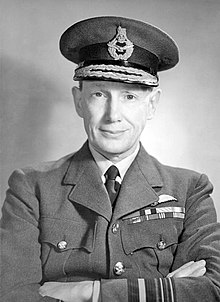Douglas Evill
| Douglas Claude Strathern Evill | |
|---|---|

Air Marshal Sir Douglas Evill c.1943
|
|
| Born |
8 October 1892 Broken Hill, New South Wales, Australia |
| Died | 22 March 1971 (aged 78) Winchester, Hampshire, England |
| Allegiance | United Kingdom |
| Service/branch |
Royal Navy (1910–18) Royal Air Force (1918–47) |
| Years of service | 1910–47 |
| Rank | Air Chief Marshal |
| Commands held |
Vice-Chief of the Air Staff (1943–46) No. 70 Squadron RAF (1923–25) No. 202 Squadron RNAS (1916–17) |
| Battles/wars |
First World War Second World War |
| Awards |
Knight Grand Cross of the Order of the British Empire Knight Commander of the Order of the Bath Distinguished Service Cross Air Force Cross Mentioned in Despatches (3) Knight of the Legion of Honour (France) Commander's Cross with Star of the Order of Polonia Restituta (Poland) Commander of the Legion of Merit (United States) Military Order of the White Lion, First Class (Czechoslovakia) |
| Other work | Deputy Lieutenant of Hampshire |
Air Chief Marshal Sir Douglas Claude Strathern Evill, GBE, KCB, DSC, AFC, DL (8 October 1892 – 22 March 1971) was an Australian-born Royal Naval Air Service pilot and squadron commander during the First World War. Serving in the Royal Air Force between the wars, he was a senior air commander during the Second World War.
Douglas Evill was born on 8 October 1892 in Broken Hill, New South Wales, Australia. After receiving a private education in England, Evill studied as a cadet at Osborne House naval college on the Isle of Wight before attending Britannia Naval College in Devon.
Evill was a cousin of the pioneer aviator Arthur Longmore who encouraged him to take up flying. After taking private flying lessons at Hendon, Evill gained his Aero Club Aviator's Certificate (No. 512) on 13 June 1913, only three months after gaining his naval commission as a sub-lieutenant. Evill then applied to join the Naval Wing of the Royal Flying Corps but was not accepted and he spent some time serving on destroyers. Evill was promoted to full lieutenant on 15 August 1914 and was appointed an acting flight lieutenant on 4 December 1914 on securing a transfer to the Royal Naval Air Service which by 1914 had gained its independence from the Royal Flying Corps.
...
Wikipedia
